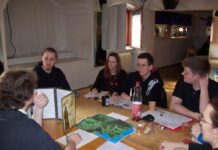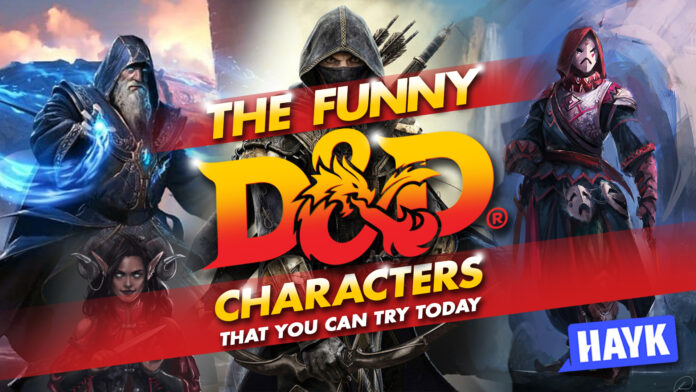
Humor is one of the best things about D&D. In most tables, there’s always a humorous player ready to make some situations light-hearted. Without humorous or funny D&D characters, adventuring sessions might feel dragging or even forced. Nobody wants that!
If you want to write and make your own funny D&D RPG character, this comprehensive article will get you started with some humorous yet functional builds. Aside from the tested builds featured in this article, you will also learn about some important tips for playing funny D&D characters from different concept approaches.
Contents of this Page
Funny Dungeons and Dragons Character Concepts
The Self-Proclaimed Deity
Preferred Classes: Bard, Cleric, Paladin
Preferred Races: Good-aligned and neutrals
Funny Rating: 3.7/5
Functional Rating: 3.9/5
Deities are powerful beings beyond the reach of mortals. The deities’ actions are influential, and their words are enough to inspire or demoralize their worshippers. But deities are not limited to otherworldly affairs anymore. Some adventurers in D&D are self-proclaimed deities with specific limitations set against their powers. If you want to feel like a divine being in D&D, you can try playing a Self-Proclaimed Deity build.
A Self-Proclaimed Deity benefits from worship-sensitive classes like Clerics, Paladins, Barbarians, Warlocks, and Bards. However, it’s not easy to convince a DM regarding a character with limited deity status. After all, gods and goddesses can spark jealousy within a party and throw off a campaign’s balance. Therefore, you need to make a reasonable backstory to convince the DM regarding your Self-Proclaimed Deity build.
The effectiveness of your deity build depends on the chosen class. The path of the Cleric will give you a better chance of reaching your character’s godhood because of divine abilities. The Paladin is also a contender because of its strong dedication to a powerful god. Another advantage of choosing Paladin is flexibility. You can easily choose from a Lawful Good or Lawful Evil path. Other classes have semi-equal chances of attaining godhood along the way.
You can make your Self-Proclaimed Deity funny by adopting a strange speech pattern. Make your character dedicated to the pursuit of godhood, but keep him grounded in the everyday problems of mortals. The drama of seriousness and daily antics will indeed be fun to watch.
The Stoned Adventurer
Preferred Classes: Any
Preferred Races: Any
Funny Rating: 3.7/5
Functional Rating: 4/5
Psychedelics are common in the realms of D&D. You can find strange plants with hallucinogenic properties and potions that can temporarily boost your character’s performance. Due to the abundance of these fantasy psychedelics, it’s acceptable to have a character based on the Stoned Adventurer template.
The Stoned Adventurer is meant for good times, partying, and casual relaxation. The Stoned build has no mechanical restrictions because it is mostly driven by roleplay. You’re even free to take some feats that can reflect the advantages and disadvantages of psychedelics.
It’s easy to roleplay a Stoned Adventurer. All you need is a slow, funny speech and a couple of humorous remarks during social encounters. You can even let the funny mannerisms bleed into combat as long as your performance isn’t affected.
A Stoned Adventurer can also be an excellent herbalist. Remember, you have to procure ingredients for your character’s psychedelic delights. In this case, you should consider taking some levels in Druid and Artificer classes.
The Jack of All Trades in DnD
Preferred Classes: Rogue (Proceed to multiclassing)
Preferred Races: Half-Elf and those with extra features and proficiencies
Funny Rating: 3.7/5
Functional Rating: 4.4/5
The worlds of D&D are filled with specialists from all walks of life. Some characters are great for bloody battles, while others are meant for back-breaking research and academia. Despite the obvious paths set for fantasy characters, some adventurers just want to forge their own ways through multiple disciplines. Such adventurers are jacks-of-all-trades, capable of doing any task but truly a master of none.
Building a jack-of-all-trades (JOAT) is a straightforward yet tedious process. Your character sheet will be filled with multiple details related to all chosen classes. Additionally, a JOAT character requires the DM’s consistent oversight. Once you got the DM’s permission, you can start by picking the Rogue class and the Half-Elf race. This rule isn’t set in stone, and you can always try a different starting race-class combo. Choosing the Half-Elf Rogue starter will give your character an extra boost in skill proficiencies.
The next step is multiclassing. Check your character’s ability scores prior to multiclassing into different class options. Most classes require at least 13 on specific ability scores.
Roleplaying a JOAT character is a fun experience. Whenever the party needs a musician, just grab a lute and start playing! You’re also not a stranger to battle due to your levels in martial classes. Now, what if someone taunts you regarding magic? Just sling a low-level spell and make that person eat his insults. The real problem appears whenever the party needs to commit to a certain route. As a JOAT, you can’t be an effective combatant, magic-user, assassin, or even a diplomat. You also need to work twice as hard to reach the competence level of a dedicated specialist. Well, you just can’t have everything!
The Classic Jester (Red Green Blue!)
Preferred Classes: Bard, Rogue, Cleric
Preferred Races: Neutral-aligned
Funny Rating: 4/5
Functional Rating: 4.4/5
Jesters are the natural comedians of any TTRPG. Almost every funny action is related to jesters, and they’re also known for being troublesome. The best thing about jester builds is their vibrant styles. Some jesters look like clowns, while others are similar to mimes with funny hats.
The best classes for a jester build are Bards, Clerics, and Rogues. These classes have their fair share of spells and combat capabilities, and they can also be funny in social encounters. Jester builds also lead to unexpected situations that may or may not benefit players.
Even though jester classes can be annoying, they can induce table drama during heavy RP situations. More often than not, players are caught off-guard by tear-jerking moments rooting out from the backstories of funny D&D characters.
The Classic Halfling Mafioso
Preferred Classes: Any except Monk
Preferred Races: Halfling
Funny Rating: 4/5
Functional Rating: 4.5/5
Generally, Halflings are good-natured creatures. They care about food, adventures, and having lots of nap time. However, some Halfling outliers are fortunate enough to climb the ladder of power and become legendary heroes of the land. Others have fallen on the wayside of evil and become servants of the coin. If you don’t want to play the traditional good Halfling, you can try the classic Halfling Mafioso build.
The Halfling Mafioso build is great for any character class except Monk. You might be hard-pressed to find a Monk-gangster because of their dedication to a spiritual calling. There are no restrictions to the Halfling Mafioso build, but you will have an easier time with high DEX, WIS, and CHA scores. Rogue is also the default priority class for the Halfling Mafioso.
Your new Halfling gangster will shine through social encounters and under-the-table deals. It’s also fun to add a mannerism to your builds such as vocal tics, constant idiom usage, and random funny actions. Personal ambition is also important, so make sure that your Halfling gangster is driven by something bigger than life.
The Orc Wizard
Preferred Classes: Wizard
Preferred Races: Orc or Half-Orc
Funny Rating: 4/5
Functional Rating: 4.5/5
Across all known fantasy realms, Orcs are always connected to beastly strength, violence, huge fangs, poor hygiene, and broken speech. Thanks to Dungeons and Dragons, it’s now easy to flip the tables and turn Orcs into witty scholars driven by academic pursuits. One such character build that goes against stereotypes is the Orc Wizard.
The best way to build an Orc Wizard is to follow the recommended ability score distribution. You can still make the character’s STR and DEX scores acceptable for melee exchanges or bashing stuff. Roleplaying the Orc Wizard is somehow challenging because you need to focus on academic pursuits while maintaining an Orcish temper. Tackling the balance of violence and non-violence is funny enough on most tables.
Another way to make the build interesting is to make the Orc Wizard delusional. Perhaps the Orc bumped his head, forgot his martial prowess, and donned the robes of a magic user. Since the Orc has severely limited spellcasting ability, he must improvise for many spells. The act of throwing pebbles can substitute for Magic Missile. The Knock spell can be represented as a loud physical knock that can destroy a door.
Multiclassing the Orc Wizard to any spellcasting class will even make the build more spontaneous. You just need to be creative in making alternative casting styles for the new spells given by the unlocked class.
The Custard-Loving Warlock
Preferred Classes: Warlock
Preferred Races: Halfling or Gnome
Funny Rating: 4/5
Functional Rating: 4.5/5
Warlocks are fun yet controversial classes. Many players love Warlocks because of their unique spells and powers granted by an omnipotent patron. Other players, however, hate Warlocks because of limited spells and firepower. However, players often forget that Warlocks are special classes built for the purpose of interesting roleplay.
Take the Custard-Loving Warlock build, for example. This character template emphasizes the sole appreciation for food (not just custards) and the shenanigans of the Warlock class. If you want to go this custard-loving route, you can choose between Halfling and Gnome as a starting class. While any class is also possible with the custardlock build, Halflings and Gnomes feel more justified because of their curious and almost-chaotic nature.
Playing the custardlock build requires creativity and timing. You just can’t hoard lots of food all the time because the campaign story might grind to a halt. Plus, other players probably want to slay monsters rather than follow your crazy food-related antics. The best time to make the custardlock shine is during relaxed social moments. Perhaps you can cook a ridiculous amount of food for your friends, or you can shop around for exotic ingredients.
If your DM is also lenient, he or she can draw up a patron related to your custardlock character. Thank your DM for following character limitations or bringing snacks to the next game session.
The Senile Adventurer
Preferred Classes: Any
Preferred Races: Any
Funny Rating: 4.5/5
Functional Rating: 3.9/5
More often than not, it’s fun to play senile characters. These characters forget major parts of their identity, leading to several funny encounters. A senile character might forget that he has prepared some spells for the day or mistake an NPC for someone else. The possibilities are near-endless for senile characters.
Most senile characters start with old age. However, you can bypass the rule by using a curse system. Perhaps your senile character was cursed by a terrifying demon many years ago. You can link the curse to the character’s backstory. Now, the character will be compelled to find a way to lift the curse!
The Senile Adventurer build will lag behind other builds in terms of combat performance. Talk to the DM and other players about this limitation. During pitched battles, forgetting a spell or a class feature is deadly. You might lose the opportunity to save a player, or you can fail a couple of saves throughout the encounter. Even though playing the Senile Adventurer is fun, losing a combat encounter is not.
The DAD
Preferred Classes: Paladin
Preferred Races: Any
Funny Rating: 4/5
Functional Rating: 4/5
The DAD build represents an overprotective adventurer who considers his party members sons and daughters. While this build is funny, it may actually have a tragic backstory. Perhaps the character acts like he does because an evil creature killed his family. The trauma probably warped the character’s mind and altered his personal goals.
Any class is compatible with the DAD build, but the one that radiates full authority is the Paladin. The DM can even make a custom oath focused on protective spells and features to support the DAD Paladin. Maybe other players can gain useful benefits whenever the DAD Paladin is nearby.
The mannerisms of the DAD Paladin are interesting. These are some mannerism choices:
- Making pack lunches instead of bland rations
- Telling bedtime stories to younger characters
- Camping trips and barbecues are part of downtime activities
- Regular fishing trips
- Constant repairs on everything
- Giving inexpensive yet memorable gifts to everyone
- Life lessons – even during awkward moments
- Setting up a party curfew
Don’t forget the DAD jokes! A great DAD Paladin has a handy collection of dad jokes that can make anyone laugh or groan.
The Hedonist
Preferred Classes: Cleric
Preferred Races: Any
Funny Rating: 4/5
Functional Rating: 4/5
The Hedonist build is all about the constant pursuit of pleasure and worldly things. Any class can follow the path of the Hedonist, but the Cleric has easy support in terms of content. With the help of the Internet, you can find numerous homebrew subclasses focused on hedonism or decadence.
Party-loving Clerics are always fun to be around. They know how to make a party extra enjoyable with just a couple of dice rolls. A homebrew decadent subclass even has several abilities that support a large-scale gathering. Whether you need a barrel of euphoric ale or a piece of sensual music to dampen the senses, you can always rely on a Hedonist Cleric.
When it comes to combat encounters, the Hedonist Cleric can deal limited points of damage per turn. At best, the character can use charming spells to take enemies out of the action pool. Nevertheless, you can always use the main Cleric abilities to increase the survivability of your Hedonist character build.
The Goblin Artificer
Preferred Classes: Artificer
Preferred Races: Goblin
Funny Rating: 4/5
Functional Rating: 4.5/5
Goblins may be fragile, but they are inherently curious and creative whenever the situation calls for it. They’re also capable of doing dangerous things to quench their curiosity at the expense of their friends or companions. A goblin’s curiosity would push through the roof if he chose Artificer as his primary class.
The Goblin Artificer’s effectiveness depends on the chosen subclass. Alchemists can make useful elixirs and reagents with the option to cast spells on the side. Armorers can nullify a goblin’s squishiness by providing a strong armor that can be arcane-modified a couple of times. Artillerist is the subclass that can truly represent a goblin’s knack for chaos. The Artillerist can use offensive spells and a magic cannon with variable firepower. Lastly, the Battle Smith subclass will allow the goblin to become a heavy hitter with the option to create a metallic pet.
If you’re playing a Goblin Artificer, don’t hesitate to share ideas to your DM. Your Artificer-powered creations can lead to enjoyable encounters and even deep micro-adventures. As the campaign goes on, you might even get the chance to build a customized workshop for your projects.
The Classic Three Kobolds in A Trenchcoat
Preferred Classes: Any
Preferred Races: Kobolds
Funny Rating: 4/5
Functional Rating: 4/5
The Three-Kobolds-in-A-Trenchcoat is a popular build in less serious D&D games and circles. It also has a stat block that DMs can use for their games. One of the best things about the Three-Kobolds build is the spontaneity of the kobolds. With the DM’s permission, each kobold has a separate attitude, social flair, and turns in combat. The uniqueness of the kobolds can lead to limited bursts of humorous conversations.
Maintaining the full persona of a ‘person in a trenchcoat’ is the challenge of the build. As a Three-Kobolds character, the player must maintain the illusion throughout the campaign or adventure. Continuous deception checks are necessary for maintaining the illusion, but spells and potions can also help.
There are many ways to build a Three-Kobold character. The first option is to pick the Kobold class from Volo’s Guide to Monsters and build accordingly. If you’re planning to pick separate classes for each Kobold, the character creation process might take longer. The second option is to ask the DM to reflavor a bulky race (example: Orc) as a deceptive Three-Kobold. Once the kobolds break their combined form, they will then play out as their respective character sheets. The third easiest option is a combination of characters and the homebrew Three-Kobold monster stat block. The player must use the stat block if the kobolds are maintaining the form. The DM must make specific adjustments to the stat block to ensure character balance.
The class combinations of the kobolds will affect their balance of fun and functionality. Turning all of the kobolds into martial classes might break the one-form illusion, but their prowess in battle will improve.
You can follow these class recommendations for your Three-Kobold character:
- Artificer – Utility and flexibility
- Wizard – Utility, firepower, and weirdness
- Bard – Best for buffing but school-dependent
- Paladin – Different oath powers
- Rogue – Utility and movement bonuses
- Fighter – Balances squishy classes
- Sorcerer – Magical utility but requires support
Of course, you can try as many class combinations as possible – including homebrewed options! You just need to convince your DM about your chosen class combination.
Tips on Playing A Funny D&D Character
Playing a funny character is more difficult than playing a regular, serious character. You have to find the right timing for your jokes, and you also need to observe other players’ reactions. Sometimes, you might feel pressured to choose between serious and silly choices that can affect the party.
Worry not! Here are some tips to help you play an interesting and funny D&D character:
Story First, Puns Second
While it’s nice to have many jokes and puns appearing in a campaign, they should be secondary to the main plot or story. Your character’s backstory should improve alongside the funny jokes and not the other way around. Characters overtly focused on raw jokes will burn out fast and might even irritate other players.
If you’re planning to build a funny D&D character, proceed with the natural character creation. What is the character’s motivation or primary goal? Why is the character humorous or silly? What are some potential secrets that can support the funny character’s ambition? You can build a multi-dimensional funny character that’s not just focused on slapstick scenarios by answering such questions.
But then again, the nature of the campaign will also affect character design. If the campaign is all about slapstick humor and consistent jokes, then a 100% silly character will truly make sense.
You must also consider if other players are not okay with slapstick humor or silly encounters. Inform the DM about the situation so that he or she can prepare solutions or alternatives.
Be Daring But Not Destructive
Most funny situations in D&D start with daring actions such as taunting enemies, navigating through social blunders, and experimenting with stuff. However, many players equate daring actions to dangerous situations, resulting in deaths or even TPKs.
If you’re planning to commit a risky action, analyze the situation beforehand. Find out the danger factors and the helpful tools at your disposal. Also, it wouldn’t hurt to boost your character’s modifiers through items, spells, abilities, and direct assistance from other players.
In case your daring action fails, your friends should have an alternative to reverse or mitigate any negative impact. The alternative can be a powerful spell, magic item, or a brokered deal from a helpful NPC.
Avoid the Main Character Syndrome
The Main Character Syndrome is one of the common problems of any adventuring group. This syndrome pertains to a player’s desire to hog the limelight and direct the fate of the party. Even though most players would love to have a leader, they must all agree on the final choice. Self-proclaimed leaders are mostly frowned upon unless the other players are impassive regarding party leadership.
Your funny D&D character shouldn’t be in the spotlight all the time. Otherwise, the players might get tired of your jokes and funny moments. Let everyone take the spotlight equally, and they will appreciate your character even more.
Be Creative With Items
In the hands of a creative player, a mundane D&D item can be the source of wonderful laughs and fun. Sometimes, you don’t need a magic item to execute a humorous plan. Just imagine the shenanigans that you can do with a simple wooden cart, a stick of dynamite, and a big crate of metal ball bearings!
Bear in mind that item usage is directly tied to your ability scores. Transcribing a scroll, for example, is affected by a high INT score. On the other hand, chugging down a barrel of Dwarven ale will test your character’s CON. Still, your DM might not require a skill check if the action is trivial and not game-breaking.
Feats can also help your character’s interaction with items. Once you’ve leveled up, consult your DM about a specific feat that can help improve your character’s growth.
Cool Gifts and Accessories for Fun-Oriented D&D Players
Do you want to take your funny D&D gameplay to another level? Well, you should check out these cool D&D items that we’ve reviewed!
Six-Pack D&D Gaming T-Shirt
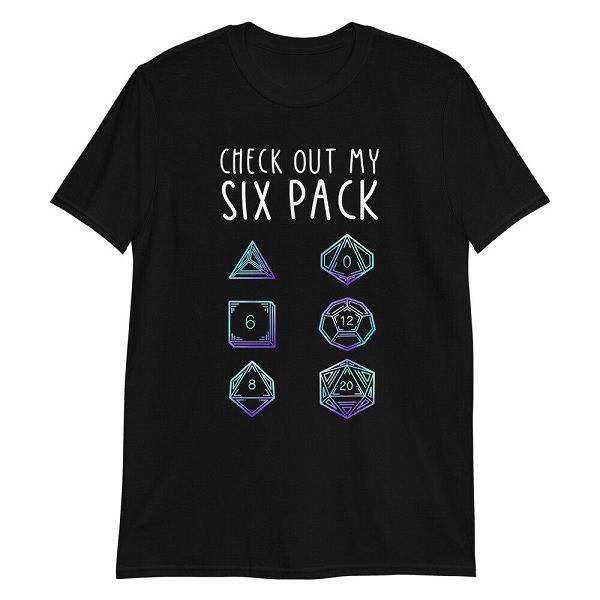
D&D shirts are always excellent gifts for enthusiasts and nerds. Nowadays, it’s easy to find a D&D shirt that emphasizes the hobby. However, only a few shirts are truly worth your time. One shirt that deserves to be in your collection is the Six-Pack Gaming Shirt from the Hero Moose store.
The Six-Pack D&D shirt comes in four outstanding colors. These are black, navy blue, dark heather, and heather blue. The shirt is also available in multiple sizes, though you need to double-check the order to avoid shipping errors. You can also order the funny 6-Pack design as a tank top, V-neck, or a hoodie.
One of the common problems of customized shirts is the quick fading design. You will notice this problem after a couple of rinses. Try to limit the Six-Pack shirt’s exposure to harsh detergents or bleach formula. If you’re traveling all the time, simply put the shirt in a secured case or pouch to preserve the design.
D&D Sarcasm Ceramic Mug
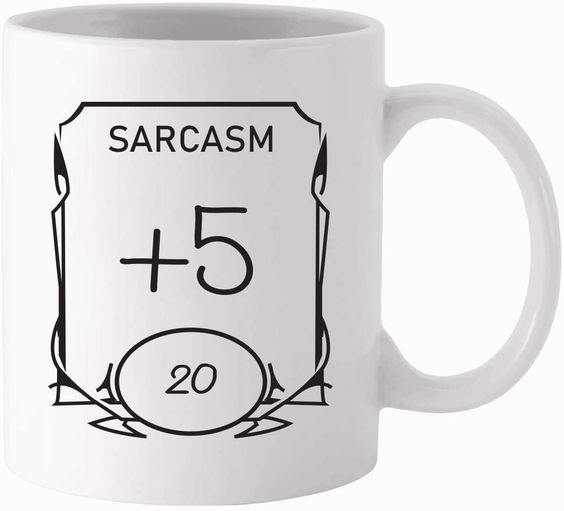
Are you looking for a simple gift that can make a D&D enthusiast’s day? You don’t need to look for something expensive. Rather, you can just get the special funny D&D Sarcasm Mug from the Funny Mugs LOL store.
The D&D Sarcasm Mug looks like any ordinary mug. However, it has a distinctive design that mimics one of the ability score boxes from the D&D character sheet. The ability imprinted in the mug is sarcasm, and it even has a +5 modifier!
Aside from looking simple yet fancy, the D&D Sarcasm Mug is highly durable. The mug even comes with a strong cardboard box that makes it resistant to impact damage.
There are no major problems with the Sarcasm Mug. You might encounter some design irregularities, such as fading lines and letters but nothing too distracting. Also, the mug is prone to staining because of its white color. If you’re not using the Sarcasm Mug, you should put it on a shelf to prevent damage and stains.
D&D Waterproof Stickers – 39 Pieces
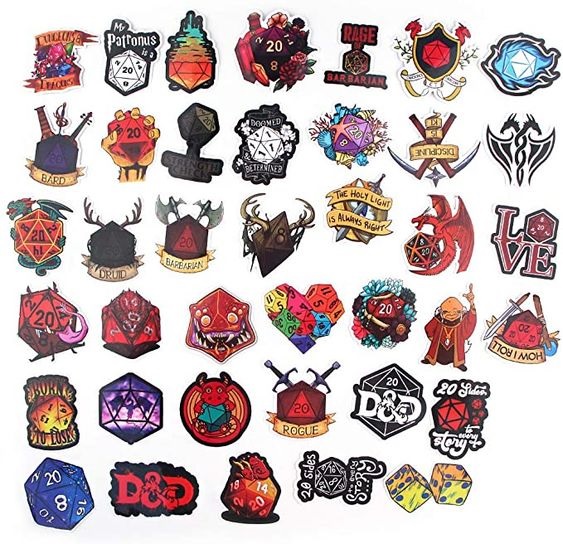
D&D enthusiasts love a good amount of stickers. The stickers represent the love for the hobby, and they even look great from afar. Instead of buying stickers one by one, you can simply check out the D&D Waterproof Sticker pack offered by the Hannal store.
All of the D&D stickers of Hannal are made of durable PVC materials. Aside from being waterproof, the stickers are also sunproof and shock-resistant. The designs are random, but they represent the common memes in D&D, such as gaming dice, weapons, dungeon master, and short class quotes. The stickers will also fit most surfaces, especially laptops, organizers, or D&D books.
You might notice thick or misaligned borders in some released product packs of D&D stickers. These inconsistencies aren’t too bothersome because of the impressive design quality and color palette. However, most of the sticker designs wear out easily – especially if they’re placed in highly exposed locations.
D&D Black Pajamas for Sleeping
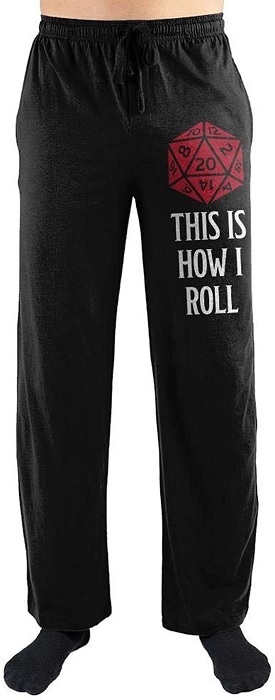
If you’re planning to collect D&D apparel, you should check out these comfortable black D&D Pajamas from the Bioworld Store. The Pajamas have a significant D20 design and a noticeable caption that says, ‘THIS IS HOW I ROLL.’
The black D&D Pajamas are available in all men’s sizes, but the long pajama sleeves tend to be long. If the sleeves are long for you, just roll them up for a couple of inches. The extra inches of the sleeves won’t bother your sleep at all!
Just like most customized pieces of apparel, the D&D Black Pajamas’ design wears out after more than ten washes. You won’t notice the worn-out design quickly because it develops over time. To slow down the design’s wear and tear, you must use a mild detergent that doesn’t mess with synthetic logos.
D&D Time-Out Jail for Bad Dice
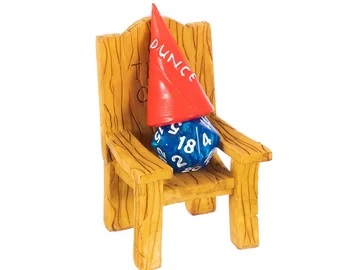
Making a bad roll in D&D can translate to death, injury, or a terrible fate. You can’t punish the DM or the imaginary forces at play at times like these. The nearest thing that you can do is to detain the die that made you roll badly. Instead of keeping the die away, you should put it on the Time-Out Chair and Dunce Hat offered by LYNX store.
The time-out chair is meant for all types of gaming dice, but it’s easier to fit with D20s. Traditional gaming dice will easily fit the chair and the hat, but ornamental ones might slide out and require multiple fitting attempts.
Since the time-out chair is made of a polymer-like substance, it has the tendency to warp at high temperatures. If you’re not using the time-out chair for dice, just store it on a shelf under room temperature and with proper ventilation.
Funny D&D Characters – An FAQ
What are the requirements for making a funny D&D character?
Answer: There are no hard requirements for making funny D&D characters, you can confirm that by checking posts of popular D&D pages and content creators. Just analyze your character deeply and do all funny mannerisms through spontaneous roleplay!
Are funny D&D characters weaker than serious characters?
Answer: No. Some funny D&D characters have strong builds that contribute to their overall humor. You might encounter funny Monks that can scale a building with just one leap or a Rogue that throws pies for sneak attacks. In some ways, funny D&D characters are stronger and more functional than regular characters.
Do I need to know lots of jokes and puns to play a humorous D&D character?
Answer: Not necessarily, but knowing lots of jokes can help. Interesting puns can lead to vibrant conversations or social encounters. It’s even better if you can connect the puns to your character’s actions.
Can funny D&D characters ruin a campaign’s balance?
Answer: All characters have the potential to ruin the balance of a campaign. There are many factors associated with a campaign’s balance such as DM experience, player agency, and encounter difficulties.
What’s the most important roleplaying tip for a humorous D&D player?
Answer: As much as possible, just go with the flow. Don’t try to inject your jokes and funny antics into every situation. There’s always a right time and place for being humorous or funny.
Aside from bards, what classes have the tendency to be hilarious?
Answer: While any class can be funny due to roleplaying, Artificers and Wizards have their fair share of the humor pie because of their class features. Artificers can make remarkable things, while Wizards can use strange spells to get what they need.
What are some cool feats for funny D&D characters?
Answer: The best feats for funny D&D characters are those that can support the build in roleplay and combat. Some examples are Bountiful Luck, Alert, Sharpshooter, Chef, Magic Initiate, Skill Expert, and Prodigy. You should also ask your DM for some custom feats to help improve your character’s effectiveness.
Conclusion
Making a D&D funny character is just the first step. The next step is playing the character right and ensuring that other players are okay with silly or funny actions. Additionally, you should also consider the opinions of other players if you’re aiming to experience seamless humorous gameplay.
Do you have funny general or dragon character concepts? Share it in the comments section below, and we might consider adding your build to the article!


